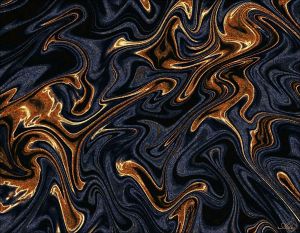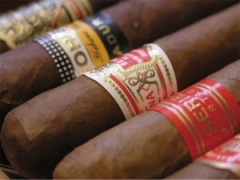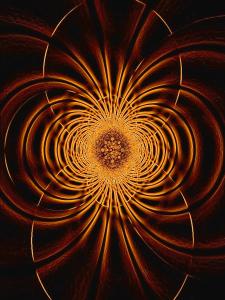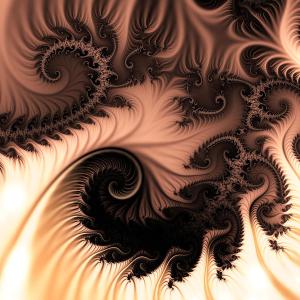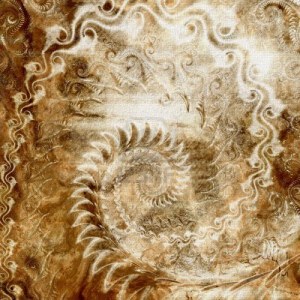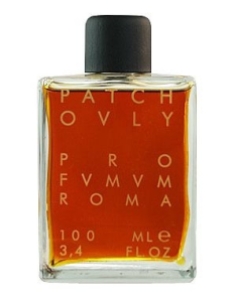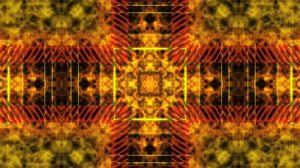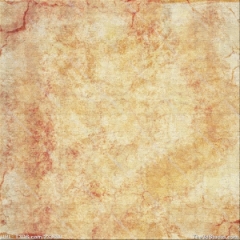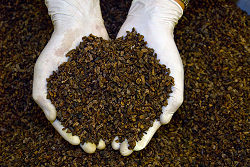According to legend and stories swirled in the mist of history, patchouli was introduced to the West by traders who used the plant’s oil or its dark, green leaves to protecting their precious cargo of silk. The plant’s naturally medicinal, sometimes mentholated or antiseptic notes would ward off insects and other marauders. When the silk hit the streets of Europe, fine ladies were enchanted by the lingering sweet smell of patchouli and demanded more of it. One version of the tale credits Napoleon with the introduction of the scent, by way of shawls that he’d brought back from Egypt and which were redolent of the plant’s sweet, earthy aroma. Today, however, the smell of true, dark patchouli has fallen into disrepute as a result of negative associations with the 1970s and “filthy hippies,” and it’s not widely used in perfumery. Yet, patchouli happens to be one my favorite notes (in its dark, chewy incarnation), so when I heard that Cuir Tabac from David Jourquin contained five different types of it, I sat up and ordered a sample right away.
David Jourquin is a French perfumer, though I’m unclear on what his exact background may be or if he was in fashion before. He has two fragrances, both riffs on the same overall theme and with slightly similar notes, but one is intended to be a “day” scent and one is meant for “night.” Cuir Tabac is the “evening” scent, while Cuir Mandarine is the day one. Both fragrances were released in 2011, are eau de parfum in concentration, and are packaged quite solidly in leather, stitched with the David Jourquin signature. As First in Fragrance puts it, “[a] chiseled jewel, sealed with wood from the walnut tree, sheathed in finely sewn Spanish leather, with a window that reveals the rare, golden hewed liquid.”
The Jourquin fragrances are inspired, in part, by the olfactory memories of his mother with her leather jacket, his visits to Guadeloupe with his father, and the impact of trips to Morocco with his step-father. Luckyscent explains a little more about the specific inspiration and scent for Cuir Tabac:
For Cuir Tabac, the nighttime version of his pair of Cuir fragrances, David Jourquin drew heavily on his childhood memories of visiting the bustling marketplace of Pointe-à-Pitre, Guadeloupe with his father. By blending the sweet and pungent scents of the market with his powerfully evocative signature leather and tobacco notes, Jourquin has created something remarkable: an enveloping, warm, and edgeless fragrance that truly feels like a memory.
The David Jourquin website describes Cuir Tabac and its notes as follows:
The heady and insolent patchouli heightens the deep and profound tobacco, cigar and musk notes overturning the senses in a soft murmur of fine eternal lavenders.
Mixed with fine lavenders as top notes.
Brown tobacco, cigar and musk as middle notes.
Five patchoulis from five Indian regions as bottom notes.
Cuir Tabac opens on my skin with every possible manifestation of patchouli imaginable. It’s dark, chewy, resinous, sweet, musky, earthy, and smoky. It’s black, but it’s also got green bits to it which result in a brief, 15-minute period of mentholated, slightly medicinal, bitter tonalities. At the same time, the patchouli is also extremely golden and pale, manifesting an incredibly creamy touch that smells a lot like milky café au lait. There are nutty undertones that are a little like roasted almonds, but there is also a faint whisper of chocolate lurking about. The whole thing is neatly wrapped up in a very quiet, subdued smokiness. It’s far from being as black as I’d like, and it lacks the weight or rich, baroque depths of the note in Profumum‘s Patchouly. Instead, it’s a lot closer to the patchouli in Serge Lutens‘ Borneo 1834 in the opening moments, mixed in with some of the creaminess of Chanel‘s Coromandel.
In less than a minute, other elements appear. First, and most prominent, is lavender which feels dry, pungent, herbaceous, and exactly like that in dried lavender sachets from Provence that I loathe so much. Thankfully, its abrasive sharpness is quickly mellowed out by the infusion of the patchouli, but it still has an edge to it that this lavender-phobe finds a little off-putting. Frankly, I’m not sure I can recall the last time I smelled a lavender-patchouli pairing, let alone one that is quite so singular and unadulterated in its focus. It’s an odd duo, and, yet, not wholly unappealing. What actually bothers me significantly more is the lurking, whip-sawing, crocodile’s tail of something synthetic that flickers around the dark waters of the base. I don’t know what it is, but it burns my nose with its razor sharpness, and continues to bother me throughout much of Cuir Tabac’s lifespan.
The third guest at the party is amber. Cuir Tabac’s perfume notes may not list amber, but there is a definite golden haze in the base that is sweet, musky, and resinous. Perhaps it’s merely another facet to the patchouli, but it seems much more resinous than just that. The whole fragrance sits atop a somewhat molten base that, at this point, is lightly tinged with a hint of creamy, almost vanillic, sweetness.
Five minutes in, the first glimmer of tobacco appears, smelling just like a fresh, unlit, Cuban cigar. If you’ve ever walked into a humidifier cigar room, you know the aroma here, though it’s very muted and subtle at first. The note also has sweet, golden, almost leathered, and floral underpinnings, and they don’t stem from the other accords so much as from the tobacco itself. Lurking about is a subtle smokiness that feels more like incense than tobacco smoke, but it may be a by-product of one of those five patchouli types.
If you’re wondering where is the leather in all this, you’re not alone. For a fragrance that is called Tobacco Leather, Cuir Tabac doesn’t actually feel like a leather fragrance at all. At no time do I ever get “leather” as a singularly dominant, individual, powerful force, at least not the leather that I’m used to. Instead, the fragrance sometimes carries the subtle feel of leather as a subset of the patchouli and resins, a manifestation of their characteristics, if you will. There are moments, much later on, when faint flickers of leather dance around the periphery, but if you’re expecting the sort of leather note that you’d find in Chanel‘s Cuir de Russie, Puredistance‘s M, Serge Lutens‘ Cuir Mauresque, Parfum d’Empire‘s Cuir Ottoman, or Montale‘s Aoud Cuir d’Arabie, then you’ll be sorely disappointed. Cuir Tabac is not a true or hardcore leather fragrance by any means, no matter what the name may say. Given that the leather is mostly more of an implied suggestion, I think a more accurate name for the fragrance might be Patchouli Tabac….
Fifteen minutes in, Cuir Tabac starts to shift a little. The patchouli’s medicinal undertones have faded, while its other features have grown stronger. Now, the patchouli has a far greater whiff of something that is slightly green and herbaceousness. Even more noticeable is the dancing, wafting aroma of nuts and cream. The patchouli has a strong element of toasted nuts, and it’s no longer just a subtle impression of almonds, but toasted hazelnuts as well. There is also a growing creaminess to the patchouli that we’ll get to momentarily. The patchouli isn’t the only one to change, however. The lavender starts to turn sweeter; it feels creamy, fluffy, and a little like lavender ice-cream.
Near the close of the first hour, I’ve become convinced that Cuir Tabac’s list of notes is incomplete. The fragrance’s undertones are smoky at times, nutty at other times, and always resinous in feel. There is an increasingly vanillic aspect to the foundation, as if Siam Benzoin and/or Tonka Bean were used to add that creamy sweetness. It becomes more prominent as time goes on, especially once the lavender recedes in strength around the 50-minute mark. Cuir Tabac is now a lovely, multi-faced patchouli fragrance with nutty, creamy, sweet, musky, dark, and vanillic touches, followed by touches of lavender and the faintest hint of fresh cigars. Unfortunately, the base continues to have that synthetic note that feels as sharp as broken glass. I tested Cuir Tabac twice, just to be sure, and the aromachemical was there each time in differing degrees of prominence. At this point, I’m chalking it up to either an amber and/or musk synthetic accord.
I still don’t smell any dominant, hardcore leather, per se, but there is a growing impression of its feel flittering about the edges. At first, there was the subtle, muted whiff of something resembling new car seats in an extremely expensive vehicle, but the smell soon gave way to an impression of an old, comfy, sweetened leather, armchair.
Honestly, I think it’s probably the power of suggestion due to the fragrance’s overall feel. Cuir Tabac has definitely started to evoke the reading room and library in an old Mayfair gentlemen’s club with its wall of books, its comfy, well-worn, dark leather armchairs, and a warm fire. There is a butler passing around cognac snifters, accompanied by the finest Belgian chocolates, and a humidor of the most expensive Monte-Cristo cigars from Havana. For those who don’t feel like drinking, there is creamy café au lait, dusted by white cocoa powder and toasted nuts. And, somewhere in the background, someone is burning a tiny, itsy-bitsy bit of black incense.
It’s all very lovely, but, alas, it’s also an increasingly soft scent. With the exception of that sharp synthetic accord, the rest of Cuir Tabac starts to feel like a very well-blended blur. Less than 75-minutes in, the notes lose a lot of their edges and shape, and the sillage drops. Cuir Tabac is a warm, slightly nebulous glow of patchouli that is creamy, sweet, a little bit smoky, slightly leathered, very nutty, and just barely infused with lavender atop a musky, ambered base. The tobacco pops up once in a while to make itself noticeable, but it generally hovers at the periphery. The “leather” impression is similarly muted. Everything feels so swirled into the patchouli that it’s really hard to pull the other notes from the cloud which hovers an inch or two above my skin.
As time passes, Cuir Tabac continues to change. At first, it’s turns into a creamy café au lait with patchouli fragrance that has a subtle whiff of lavender, synthetics, and tobacco. Then, at the start of the third hour, the tobacco returns to the fold and starts to tango with the patchouli. Now, it’s no longer uncut Cuban cigars, but sweetened pipe tobacco infused with patchouli. The latter is still simultaneously creamy and dark, but all the subtle leathered, nutty, and incense undertones have vanished.
The fragrance sits right on the skin, and feels increasingly thin, gauzy, and discreet. It’s frustrating trying to pull the notes out of the air, especially as some of them keep coming and going like ghosts. Just like the tobacco did earlier, it’s now the vanilla’s turn to play hide and go seek. The same story applies to the creamy and milky café au lait tonality. Clearly, the fragrance is very well-blended and reflects different facets on different occasions, but I wish it had more body, depth, and structure. Both times I wore it, the results were slightly different in terms of the small details, as well as in the order and prominence of all the notes except for the patchouli, but the nebulous feel of the fragrance was the same.
About 4 hours in Cuir Tabac’s development, the fragrance settles down for its final stage. It is now a creamy, vanilla patchouli fragrance with subtle whiffs of sweetened, unlit pipe tobacco, along with the tiniest speck of smoke and musk. It is also now a complete skin scent, as sheer as gauze. Cuir Tabac remains unchanged until its final moments, a little under 11 hours from its start.
In some ways, it seems that Cuir Tabac dissolves in on itself, but you can also argue that it’s meant to be a soft glow that discreetly envelops you before it turns into something more personal. The latter interpretation seems to be supported by David Jourquin’s somewhat abstract attempts at philosophical, poetic stylings on his website, both in the section about him and the one devoted to his philosophy. The references to dark shyness, “a secret wake like a promise,” and “firm determination enveloped in infinite softness and warmth” seem to be as much about his fragrances as they are about him. Then, too, there is the part about how “[h]e is like his fragrance, sensitive, secret, calm and yet bubbling over, motivated by an intense passion.”
So, if Cuir Tabac is intentionally meant to be this secret, quiet, shy whisper of softness and warmth, then I can hardly criticize the perfumer for achieving his goal. I know a number of people who prefer wispy, gauzy, soft scents that remain close to the skin and are just a private message to themselves. If they like dark patchouli, then Cuir Tabac is tailor-made for them. However, even they might not think the perfume was worth it for the price and accessibility issue. Cuir Tabac is an eau de parfum that costs $235 or €168 for a 100 ml/ 3.4 oz bottle, and has only limited distribution. In the U.S., only Luckyscent carries it. I couldn’t find any vendors in Canada, the U.K., Oceania, and vast swathes of Europe, though it is carried by Germany’s First in Fragrance, and there are plenty of vendors in France and Russia. My point is, would someone want to risk a wispy, unobtrusive blur of a scent that is quite expensive and, for many perfumistas in different parts of the world, not easy to test out first?
Judging by the handful of reviews for Cuir Tabac on Fragrantica, the answer would be “no.” In fact, almost all the reviews say the same thing: that the fragrance is too discreet, “puny,” and sheer for the price tag. To wit:
- God bless the individual that’s willing to spend hundreds of dollars on this fragrance. The problem with Cuir Tabac isn’t the scent. The bigger issue is that you’re gonna be playing the olfactory version of “Where’s Waldo”. This is more like a thin scent rather than a skin scent. The tobacco smells like a walk-on instead of the star in this concoction. The rest of the notes are puny and shows no interest in fighting back the tyranny of fleetingness. Definitely not a fragrance built for the playoffs.
- Starts out with almost only dry strong patchouli and a hint of pipe tobacco, soon to transform into more like the smell of a warm – unlit – cigarette and a more subtle spicy note. [¶] Two hours later what’s left is a discrete patchouli note and a warm very present, yet not aggressive, amber-like touch. [¶] Beautiful scent but less isn’t always more and maybe this one would’ve been better off with more potency.
- For the first hour, you get hints of sweet pipe tobacco, quickly overshadowed by a medicinal tone (probably the mix of lavender & patchouli). I typically enjoy both lav & patch, but something is awry with this particular mix. After the lav & patch fade, you get the sweet pipe tobacco that I remember my grand uncle (mother’s uncle) smoking, for hours to come. Is this stuff good? In a word, yes. Do I wanna smell like my 70+ year-old uncle? No. And I really don’t wanna pay $235 USD to 🙂
The “Where’s Waldo?” comment is brilliant, and my hat is off to “Roge” who used it! I think the reference definitely applies not because of the scent itself, on my skin at least, but because of how many of its notes just vanish like a ghost, only to occasionally reappear later, or how hard they are to pull out of the nebulous patchouli cloud. Lord knows, if one expects a true leather fragrance, Cuir Tabac will be “Where’s Waldo” indeed! If you will note, not a single one of those comments (or the remaining few on Fragrantica) mentions leather at all. Odd for a purported “Cuir” fragrance, wouldn’t you say? I’m relieved that it’s not just me. As for the tobacco, judging by those comments, it seems to have played hide-and-go seek with a few other people as well, since the reports are quite split on its prominence.
One thing that needs some elaboration, however, is the issue of Cuir Tabac’s longevity. The thin, unobtrusive nature of the scent and its low sillage clearly was a problem for two of the commentators quoted up above. However, if you look at the votes on Fragrantica, the majority voted for “very long lasting” (12+ hrs), followed by “long lasting” (7-12 hrs) in second place. In short, don’t let the fragrance’s wispy nature and weak sillage fool you.
An unrelated topic brought up by Fragrantica is the issue of similar scents. One commentator found absolutely no difference between Cuir Tabac and its sibling for the day, Cuir Mandarine. Another thought Cuir Tabac was too similar to the more affordable Thierry Mugler fragrance, A* Men Pure Havane. I haven’t tried the latter, but I’ve read that it’s a very honey-dominated fragrance, not a patchouli one. Still, if the similarities are true, then it makes Cuir Tabac seem even more pricy.
Ultimately, I think that Cuir Tabac is a very mixed bag. The creamy bits are lovely, as is the café au lait undertone that sometimes vaguely mimics a similar nuance in Chanel‘s Coromandel, and I always enjoy dark patchouli, even when mixed with lavender. Unfortunately, I had enough problems with the scent that, at that price range, I would far prefer to get Profumum’s glorious, smoky Patchouly soliflore with its incredible concentration, baroque richness, salty ambergris, and lack of razor-sharp synthetics. Still, if money is no object, if you prefer your patchouli to be gauzy, lightweight, and discreet, and if you also enjoy lavender, but don’t like leather or dominant tobacco notes, then Cuir Tabac may be for you. It’s an extremely narrow category of perfumista, but I’m sure you’re out there!





